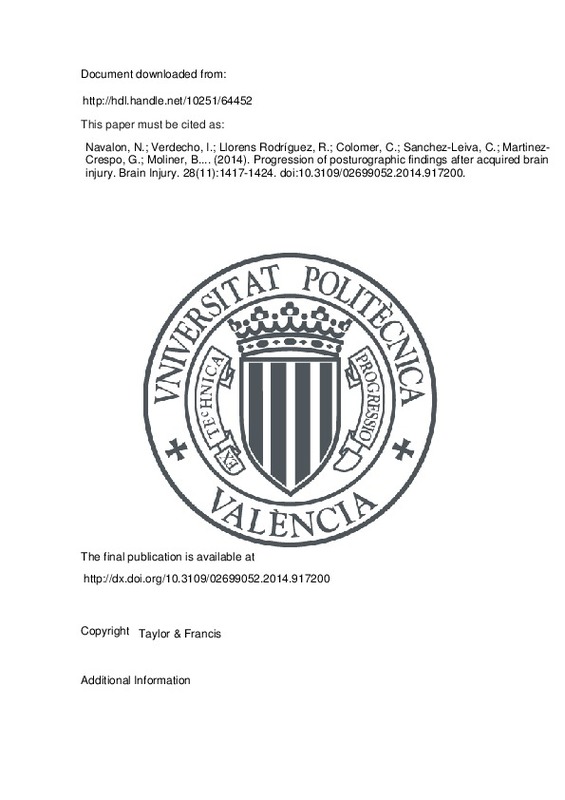JavaScript is disabled for your browser. Some features of this site may not work without it.
Buscar en RiuNet
Listar
Mi cuenta
Estadísticas
Ayuda RiuNet
Admin. UPV
Progression of posturographic findings after acquired brain injury
Mostrar el registro sencillo del ítem
Ficheros en el ítem
| dc.contributor.author | Navalon, N.
|
es_ES |
| dc.contributor.author | Verdecho, I.
|
es_ES |
| dc.contributor.author | Llorens Rodríguez, Roberto
|
es_ES |
| dc.contributor.author | Colomer, C.
|
es_ES |
| dc.contributor.author | Sanchez-Leiva, C.
|
es_ES |
| dc.contributor.author | Martinez-Crespo, G.
|
es_ES |
| dc.contributor.author | Moliner, B.
|
es_ES |
| dc.contributor.author | Ferri, J.
|
es_ES |
| dc.contributor.author | Noe, E.
|
es_ES |
| dc.date.accessioned | 2016-05-20T06:35:40Z | |
| dc.date.available | 2016-05-20T06:35:40Z | |
| dc.date.issued | 2014 | |
| dc.identifier.issn | 0269-9052 | |
| dc.identifier.uri | http://hdl.handle.net/10251/64452 | |
| dc.description.abstract | Objective: To study the characteristics of balance performance in a sample of patients with increasing postural instability after acquired brain injury (ABI) and to establish the clinical utility of a new computerized posturographic system (NedSVE/IBV). Methods: This study included 108 patients with ABI divided into five groups from minimal to severe postural impairment. All patients were assessed with the NedSVE/IBV system and with traditional balance measures. Posturographic analyses included the modified clinical test of sensory interaction on balance, the limits of stability and the weight-shifting test. Sensitivity to detect changes and reproducibility were evaluated in 63 patients who were followed-up for 6 months and in 20 patients who were evaluated on two separate occasions during the same week, respectively. Results: The patients showed reduced stability limits, abnormal postural responses and an increased reliance on visual input with differences in intensity directly related to their degree of balance impairment. Posturographic study showed excellent convergent validity, reproducibility and sensitivity to detect changes. Conclusion: The data suggests that, regardless of the intensity of postural instability, there is a common mechanism of sensory processing to maintain balance after ABI. The NedSVE-IBV system is a valid tool to quantify balance after ABI. | es_ES |
| dc.language | Inglés | es_ES |
| dc.publisher | Taylor & Francis | es_ES |
| dc.relation.ispartof | Brain Injury | es_ES |
| dc.rights | Reserva de todos los derechos | es_ES |
| dc.subject | Assessment | es_ES |
| dc.subject | Assistive technology | es_ES |
| dc.subject | Balance | es_ES |
| dc.subject | Evaluation | es_ES |
| dc.subject | Measurement | es_ES |
| dc.subject | Outcome | es_ES |
| dc.title | Progression of posturographic findings after acquired brain injury | es_ES |
| dc.type | Artículo | es_ES |
| dc.identifier.doi | 10.3109/02699052.2014.917200 | |
| dc.rights.accessRights | Abierto | es_ES |
| dc.contributor.affiliation | Universitat Politècnica de València. Instituto Interuniversitario de Investigación en Bioingeniería y Tecnología Orientada al Ser Humano - Institut Interuniversitari d'Investigació en Bioenginyeria i Tecnologia Orientada a l'Ésser Humà | es_ES |
| dc.description.bibliographicCitation | Navalon, N.; Verdecho, I.; Llorens Rodríguez, R.; Colomer, C.; Sanchez-Leiva, C.; Martinez-Crespo, G.; Moliner, B.... (2014). Progression of posturographic findings after acquired brain injury. Brain Injury. 28(11):1417-1424. doi:10.3109/02699052.2014.917200 | es_ES |
| dc.description.accrualMethod | S | es_ES |
| dc.relation.publisherversion | http://dx.doi.org/10.3109/02699052.2014.917200 | es_ES |
| dc.description.upvformatpinicio | 1417 | es_ES |
| dc.description.upvformatpfin | 1424 | es_ES |
| dc.type.version | info:eu-repo/semantics/publishedVersion | es_ES |
| dc.description.volume | 28 | es_ES |
| dc.description.issue | 11 | es_ES |
| dc.relation.senia | 271826 | es_ES |







![[Cerrado]](/themes/UPV/images/candado.png)

